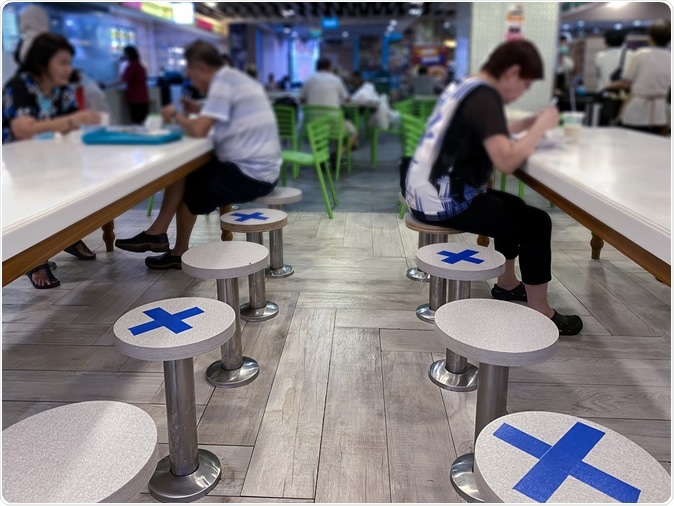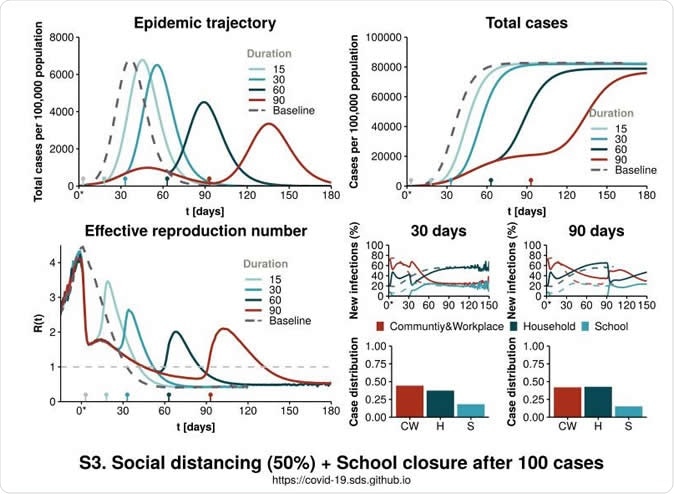Since the second wave of the coronavirus disease (COVID-19) emerged in Europe, many countries have imposed social distancing measures in the form of community quarantines and lockdowns. Wuhan City in China, where the virus first emerged, has been in lockdown since Jan. 23rd and is only just attempting to return to normal daily life.

Singapore Mar: 2020. Social distancing rules in practice, alternate seating in local public food courts (restaurants, food outlets), to reduce risk of further transmission; safety measures Image Credit: Kandl / Shutterstock
A new international study based on census and real-world mobility flow show that social distancing and the complete isolation of the population amid the coronavirus disease outbreak are strategies that need to be kept in place otherwise there is a high possibility of a second outbreak if these measures are not maintained over a prolonged period.
The researchers found that social distancing is a measure that is working and should continue. Currently, there are mitigation strategies in place across the globe, with most focusing on social distancing to curb the spread of the virus.
“Before the need to adopt measures to contain and eradicate the current COVID-19 pandemic, we have simulated the evolution of the epidemic in a real-world population, in this case, within the area of Boston. Our models show us that a new wave of infection is highly likely in almost all scenarios. The fundamental conclusion is that passive containment policies should be combined with other more aggressive measures,” Yamir Moreno, theoretical physicist, co-author of the study, said in a statement.

Evaluation of scenarios for different containment measures. In most cases, there is a high possibility of a second outbreak if these measures are not supported over a prolonged period.
Realistic modeling approaches
With all the guidelines of social distancing, realistic modeling approaches could shed light on what to expect and what are the best actions needed during the global pandemic. These modeling efforts can save millions of lives.
The new study, however, answers essential questions on the expected impact of current social distancing strategies in place, how long these measures should be in place, what is the probability of a second outbreak or reemergence, and what is the best way to mitigate the current pandemic.
To arrive at their findings, the team used real-world mobility data from mobile phone users in the United States. The data came from the Boston area via Cubeiq, a company that records the locations of users. They also collected sociodemographic data from the U.S. Census.
“We are also currently working with real-world mobility data in New York City, which is the current epicenter for the epidemic in the U.S.
If high-resolution mobility data is available, our approach can be easily replicated for new cities or countries to measure the impact of social distancing strategies before the epidemic,” Esteban Moro, a professor in the Department of Mathematics at the UC3M and co-author of this study, said.
With the collected data, the team created one network showing the contact patterns of approximately 100,000 agents in the Boston area over four months, including three layers – community, households, and schools.
Study findings
The team has found that the best strategy is social distancing, with 90 percent of adoption and non-essential closures. However, the researchers noted that once strict measures of social distancing are lifted, it may increase the risk of having a second outbreak. Thus, these measures should be implemented for an extended period to maximize their efficacy.
Governments and countries should apply active strategies to prevent this from happening, and they would include mass testing, isolation of new cases, contact tracing of possible infected people, and remote symptoms monitoring.
Aside from these, the team discovered that school closures do not have a significant impact on controlling the spread of the virus. Even if schools are closed, infections can still occur in homes and the community.
Further, passive social distance strategies are not enough to prevent the spread of the virus. Instead, extensive testing, contact tracing, and isolation of infected individuals are required to contain the viral infection.
Full confinements would not be enough. They are not solutions to the problem since, without active measures, new outbreaks may ensue.
The World Health Organization (WHO) recommends social distancing to prevent the spread of the virus by maintaining 1 meter or 3 feet distance between people, especially those who are coughing and sneezing.
Sources:
Journal reference: